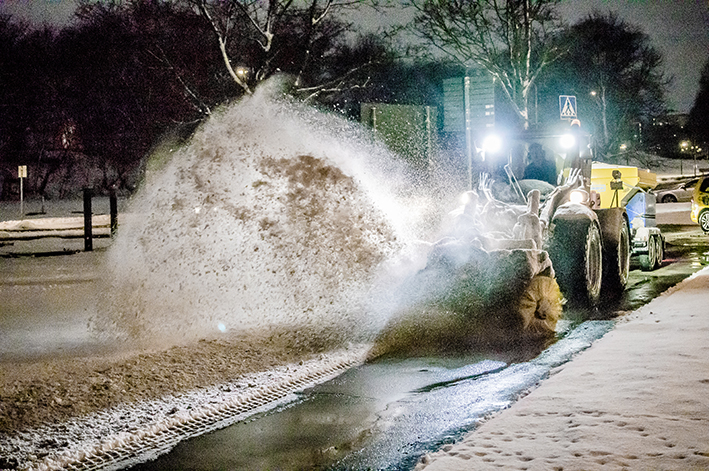The Swedish National Road and Transport Research Institute (VTI) has analysed the conceivable advantages and disadvantages of sweep-salting bicycle paths in Karlstad, a seaside town in Sweden with an estimated 90,000 inhabitants. The town’s location and climate make sweep-salting a good method for keeping the bicycle paths passable in winter.
Many towns are now making efforts to ensure that the proportion of trips made by bicycle will increase in wintertime as well. One winter road maintenance method that has gained greatly in prevalence is sweep-salting, in which a sweep roller sweeps away the snow and skidding is combated with brine or pre-wetted salt.
“In this way we avoid leaving sand on the bicycle paths, eliminating the risk of rolling gravel in the springtime. On the other hand, there is the risk of spreading more salt”, says VTI researcher Göran Blomqvist.
VTI has previously evaluated sweep-salting in Linköping and Stockholm, with favourable results. Karlstad Municipality has called on VTI to analyse the conceivable advantages and disadvantages of sweep-salting the bicycle paths in Karlstad, and to offer recommendations as to its possible continued use.
“Karlstad’s location and climate potentially make sweep-salting a successful winter maintenance method for bicycle paths, but one that could also be particularly demanding”, says Blomqvist.
Sweep-salting is more resource-intensive than traditional sanding and ploughing, and also imposes heavier requirements in terms of preparedness and execution. It requires the know-how and capacity to track and interpret weather forecasts so that preventive work can be done to stop skids from occurring.
“The level of ambition among Karlstad’s operation managers favours success with sweep-salting. There will understandably be a certain ‘breaking-in period’ for both managers and machine operators before the method can work optimally, and they will need to follow up on their activities and pool their experiences”, says Blomqvist.
High ambient humidity in Karlstad
Karlstad is characterised by the extent of its open waterways. The sweep-salted stretches of bicycle path run largely along the Klarälven River, where the ambient humidity level is high. Moisture precipitated on the bicycle paths can dilute the salt, meaning that those in charge need to bear in mind that salting measures will not be effective for long, and that the risk of icing will be great.
“It has long been well known that salt has negative environmental effects, and the public often reacts negatively to increased salting. It is therefore important to optimise salt use so that no more salt is used than necessary”, says Blomqvist.
Survey studies conducted before and after the trials indicate that public perceptions of the salting of the bicycle paths were somewhat more positive after the sweep-salting trials than before.
Facts about the study
The analyses are based on theoretical correlations and a mapping of measures undertaken in the winter of 2014–2015. These measures were linked to prevailing weather conditions by analysing data from the Swedish Transport Administration’s road weather information system, VViS. The researchers also took public opinion into account based on surveys conducted, Facebook posts, and inquiries received by the municipal customer centre regarding the winter maintenance of pedestrian and bicycle paths.
Report:
VTI notat 25-2015, Sweep-salting in Karlstad: challenges and opportunities
Link to report (in Swedish only)
 Contact: Contact:Göran Blomqvist, Researcher goran.blomqvist@vti.se VTI, Sweden |








Follow us: